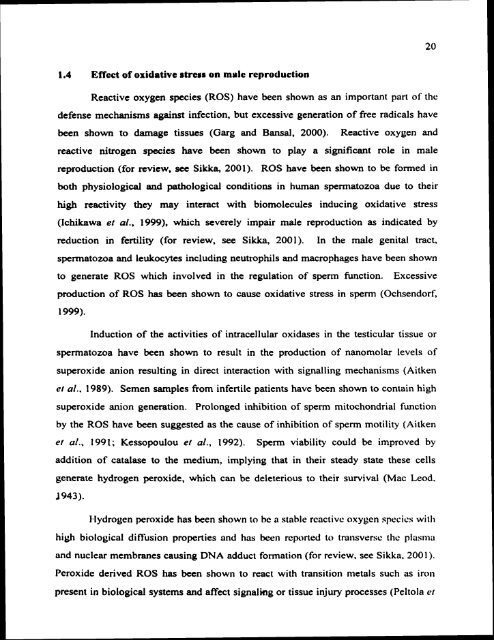ON TESTIS AND EPlDlDYMlS OF RATS - Pondicherry University ...
ON TESTIS AND EPlDlDYMlS OF RATS - Pondicherry University ...
ON TESTIS AND EPlDlDYMlS OF RATS - Pondicherry University ...
Create successful ePaper yourself
Turn your PDF publications into a flip-book with our unique Google optimized e-Paper software.
1.4 Effect of oxidative stress on mvlc reproduction<br />
Reactive oxygen species (ROS) have been shown as an important part of thc<br />
defense mechanisms against infection, but excessive generation of free radicals have<br />
been shown to damage tissues (Garg and Bansal, 2000). Reactive oxygen and<br />
reactive nitrogen species have been shown to play a significant role in male<br />
reproduction (for review, see Sikka, 2001). ROS have been shown to be formed in<br />
both physiological and pathological conditions in human spermatozoa due to their<br />
high reactivity they may interact with biomolecules inducing oxidative stress<br />
(Ichikawa el 01.. 1999). which severely impair male reproduction as indicated by<br />
reduction in fertility (for review, see Sikka, 2001). In the male genital tract,<br />
spermatozoa and leukocytes including neutrophils and macrophages have been shown<br />
to generate ROS which involved in the regulation of sperm function. Excessive<br />
production of ROS has been shown to cause oxidative stress in sperm (Ochsendorf,<br />
1999).<br />
Induction of the activities of intracellular oxidases in the testicular tissue or<br />
spermatozoa have been shown to result in the production of nanomolar levels of<br />
superoxide anion resulting in direct interaction with signalling mechanisms (Aitken<br />
er 01.. 1989). Semen samples from infertile patients have been shown to contain high<br />
superoxide anion generation. Prolonged inhibition of sperm mitochondria1 function<br />
by the ROS have been suggested as the cause of inhibition of sperm motility (Aitken<br />
er 01.. 1991; Kessopoulou er ol., 1992). Sperm viability could be improved by<br />
addition of catalase to the medium, implying that in their steady state these cells<br />
generate hydrogen peroxide, which can be deleterious to their survival (Mac Leod.<br />
1943).<br />
t-lydropen peroxide has been shown to k n stnhlr rcnctlvc oxygen sprcics with<br />
high biological diffusion properties and has been reported to transvrrsc thc plasma<br />
and nuclear membranes causing DNA adduct formation (for review. see Sikka. 2001).<br />
Peroxide derived ROS has been shown to react with transition metals such as iron<br />
present in biological systems and affect signaling or tissue injury processes (Peltola el

















